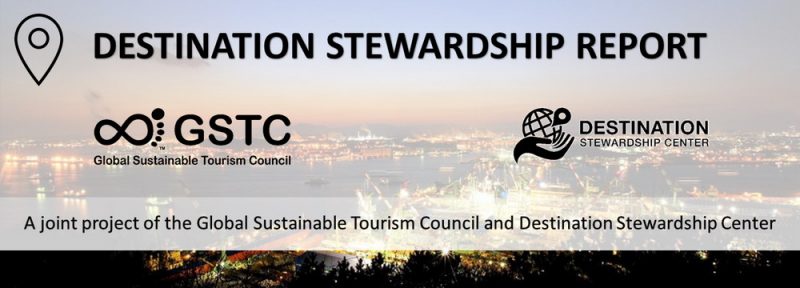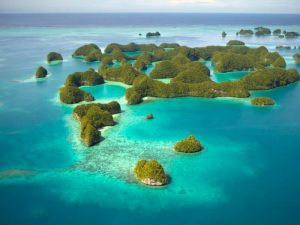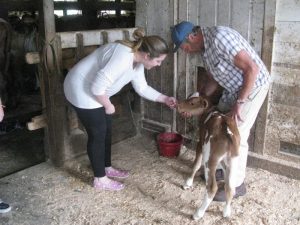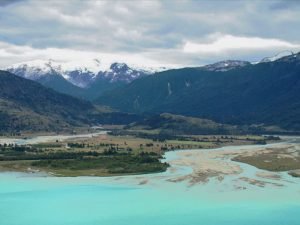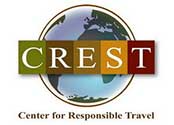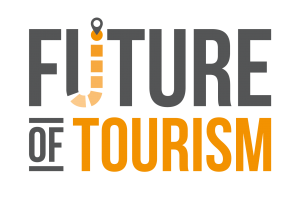Destination Stewardship Report
Summer 2021 July-September (Volume 2, Issue 1)
The Destination Stewardship Report is an e-quarterly collaboration between the Destination Stewardship Center and Global Sustainable Tourism Council. Our goal is to provide practical information and insights useful to anyone whose work or interests involve improving destination stewardship in a post-pandemic world.
Please subscribe HERE if you have not done so already. For more information and participation contact us. — Jonathan Tourtellot, Editor
Palau: A Conservation Culture
The Micronesian nation of Palau has been gaining a reputation not only for trail-blazing conservation measures, reports Tiffany Chan, but also for putting the brakes on irresponsible mass tourism. Now they’ve set their sights on carbon neutrality.
Micronesian Archipelago Leads the Way in Pacific Stewardship
Children of Palau
I take this Pledge
To preserve and protect your beautiful and unique Island home…
– From the Palau Pledge
The tiny island nation of Palau is known worldwide for its marvelous environment – turquoise waters, unexplored lands, biodiversity – and for the innovative regulations that have been implemented to ensure its pristine condition. This Micronesian country of hundreds of islands, however, has been facing many challenges due to high-volume tourism growth… READ MORE →
Localizing a Vermont Tour
A key part of good destination stewardship is to favor tour operations that support the people who live there. But does that really work in practice? And actually make money? Agritourism specialist Todd Comen decided to give it a try in his home state of Vermont.
Hypothesis: Integrated Rural Tourism Actually Works
In 2015, I wanted to test a theory of rural tourism: my own. In the year 2000 I had introduced a theory of Integrated Rural Tourism at the 1st World Congress on Rural Tourism held in Perugia, Italy, organized by Prof. Adriano Ciani of the University of Perugia. The theory went something like this: In rural communities, entrepreneurs can supplement their income stream by delivering services to visitors based on their personal strengths and core assets, and once a number of entrepreneurs successfully do this, the rural communities in which they live and work begin to experience… READ MORE →
Doing It Better: Pennsylvania Wilds, USA
It’s a destination described by one expert as having “one of the greatest, rural, natural resource-based economic development programs in the U.S.” The remarkable Pennsylvania Wilds here joins our ongoing “Doing It Better” series on places with a holistic approach to destination management in the spirit of GSTC Destination Criterion A1. Over the past three years two DSC volunteers, Ellen Rugh and Jacqueline Harper have been collecting and documenting information on the region’s remarkable PA Wilds Center. Here is their report.
Holistic Destination Regeneration, from Conservation to Design
This forested multicounty region in northwest Pennsylvania, once known as the “timber capital” of America, was depleted of its trees and wildlife by the beginning of the 20th century. Poor forest management and increased demand for lumber led to raging wildfires and floods. The elk population went extinct; the whitetail deer nearly so. With the timberlands denuded and an oil boom played out, the region went into decline. The government ended up buying the land to create state and national forests. Now, after 100 years of conservation, the rebranded “Pennsylvania Wilds” has been restored and hosts a rich, thriving forest that educates others on the importance of responsible forestry. One opportunity for regenerating the depressed region was tourism… READ MORE →
Two From Chile: A System and a Framework
Chelenko Opts for Sustainability
Some beautiful destinations are recognized as such with special governmental designations. That may provide an opportunity for a holistic approach to destination management. Fernando Ojeda and Natalia Naranjo describe how the Chelenko Lake area of the Chilean Patagonia has done just that.
Chile’s Chelenko Adopts a Structure for Stewardship
Chelenko is a scenic, nature-based destination in the Aysén region in the Chilean Patagonia. The Chilean government designated it a Touristic Interest Zone (Zona de Interés Turístico – ZOIT) in 2000, due to rising tourism and an increasing need to protect the lake… READ MORE→
Human Encounters
Lessons from the pandemic have revealed how stronger rural communities can make for stronger cross-cultural touring, say Ann Becker and Jorge Moller Rivas. They propose a framework for doing so.
Pandemic Insights Suggest a Course for the Future
As long-time travel leaders, we joined forces in 2019 to create and lead a US/Swiss women’s small group cross-cultural exchange trip predominantly in the Araucania region of Chile, home to the majority of the native Mapuche. Our group experienced homestays in traditional rukas, stayed in locally owned lodges… READ MORE→
Resources for Tourism Recovery
The DSC’s Cultural Heritage Editor, Lucy Matthews, has been scouring the Internet for information that might help destinations plan a reboot as the pandemic recedes. Here’s what she found – from WTTC, UNWTO, and, interestingly, the U.S. state of Maryland.
Better Stewardship – a Pandemic Recovery Trend
It’s no trade secret that the tourism industry has been hit hard by the pandemic. According to the World Travel & Tourism Council’s (WTTC) Travel & Tourism: Economic Impact 2021 report, the industry experienced a dramatic decline from a total GDP contribution of 10.4% in 2019 to 5.5% in 2020, and job numbers fell from 334 million (2019) to 272 million (2020).
The WTTC report from September 2020, “To Recovery & Beyond: The Future of Travel & Tourism in the Wake of COVID-19,” suggests a variety of trends… READ MORE→
Webinar Reports
Overtourism’s Lessons for Tomorrow
“In 2019, over 1.5 billion tourists crossed international borders and tourism’s continued growth seemed assured. However, in 2020, tourism stopped in its tracks. The world went from overtourism to no tourism.” – Kelsey Frenkiel, Program Manager at the Center for Responsible Travel (CREST) and co-editor of Overtourism: Lessons for a Better Future (Island Press).
On June 2nd, 2021, the Overtourism to No Tourism Webinar convened four writers from the new multi-author book, Overtourism: Lessons for a Better Future. Rebecca Clarke reports on the panel’s discussion of why it is necessary to build a sustainable tourism industry, particularly in the post-pandemic period, and how destinations can go about doing so… READ MORE→
“Reset Tourism” Webinar Series – Metrics and Supply Chains
The Future of Tourism Coalition’s four-part “Reset Tourism” series is intended to help destinations emerge from the Covid crisis with new forms of governance and collaboration that will enable a more holistic and sustainable approach to tourism management and development. Our Spring 2021 issue covered the first webinar, on destination stewardship. Below, Jane Slaughter reports on the next two, which address better measures of success (#2) and sustainable supply chains (#3). The fourth, about tools for implementation, is planned for later this year… READ MORE→
For Your Information
Publications and more
• Spenceley, A. (2021). Handbook for Sustainable Tourism Practitioners: The Essential Toolbox. Edward Elgar Publishing. “This insightful Handbook brings together the practical guidance of over 50 international practitioners in sustainable tourism. Applying strong research design principles, it provides a workable and rational toolkit for investigating practical challenges….” See the Winter 2021 Destination Stewardship Report for an excerpt.
• Honey, M. (2019). Cruise Tourism in the Caribbean: Selling Sunshine. Routledge: “explores the lessons learned from half a century of Caribbean cruise tourism; one of the most popular and profitable sectors of the tourism industry.”
• Pilling, D. (2018). The Growth Delusion: Why economists are getting it wrong and what we can do about it. Tim Duggan Books. An entertaining (!) economics book with no mention of tourism but profound implications for measuring its success.
• Goodwin, H. (2016). Responsible Tourism: Using tourism for Sustainable Development. Goodfellow 2nd Edition “is about the globally vital necessity of realizing sustainable tourism. It is a hugely important challenge to those who organize and sell travel and tourism, and those who consume it.”
Note: quotes are publisher blurbs
Submissions Requested
The Destination Stewardship Report relies entirely on submitted articles and notices, not to mention corrections and suggestions. All submissions must: • pertain to some aspect of destination stewardship; • be shorter than 1,000 words, and; • avoid self-promotion. Photos welcome. What story can you tell that would help others?
Please contact us with your ideas. Your next issue is planned for October 2021.
Destination Monitor
- Cruise Lines Drown Local Wishes | Yahoo – In Key West and Venice, megaship bans get overruled
- French National Park Discourages Tourists | Washington Post – Overtrodden Calanques launches de-marketing campaign
- Kenyan Conservancies Survive Loss of Tourism | Nat Geo (subscribers only)
- Venice: Quiet No More | WSJ
- U.S. National Parks Strain Under Visitor Influx | WSJ – Overtourism returns as gates close early
- Nantucket Locals War Over Vacation Rentals | WSJ – STR issue polarizes U.S. island
- Fresh Start for Overcrowded Europe? | DW
➢ DSC’s Destination Monitor and Travindy offer continuing selections of news stories.
Volunteers needed
• The Center for Responsible Travel (CREST) offers an internship program that provides real-world sustainable tourism educational opportunities to outstanding students from around the world. Two internships are available: «Programs & Research» and «Communications.» Applications by Wednesday, July 28.
• The Destination Stewardship Center seeks an experienced managing editor for this Report, as well as a tech-savvy gap-year graduate or apprentice (WordPress, MailChimp, and Google Suite) – contact us.
• Tourism Cares can always use some help.
Sponsored by:


Editor – Jonathan B. Tourtellot
Illustrations Editor – Gabe Gerson
Assistant Editor – Harmony Lamm
Editorial assistance – Cynthia Linnell, Lucy Matthews, Martha Mulokoshi, Tiffany Chan, Rebecca Clarke, Jane Slaughter, Hannah Anderson
Newsletter design – Sarah Bacharach
Distribution – Tiffany Chan


